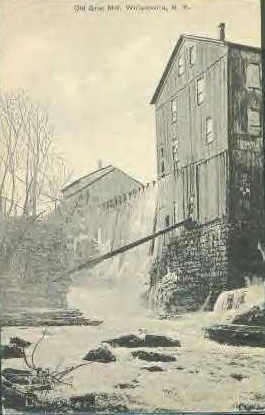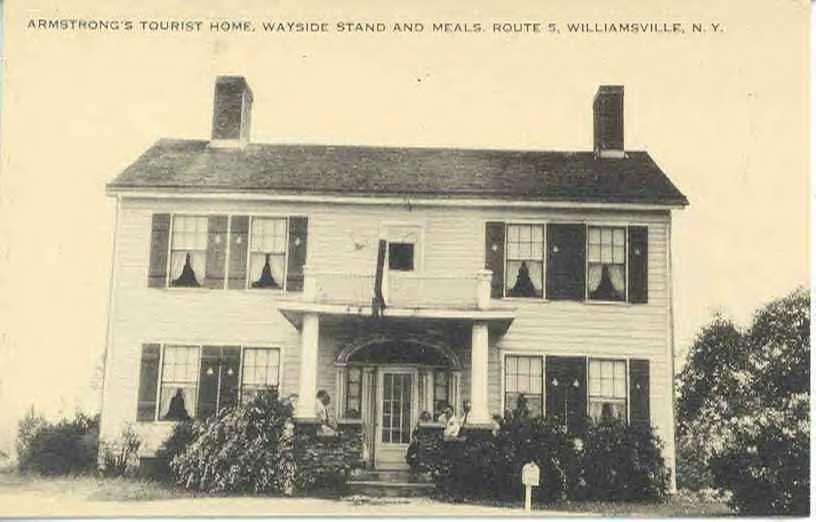A HISTORY of
the TOWN of AMHERST, NEW YORK
By
SUE MILLER YOUNG
1965
Previous
Chapter | Table
of Contents | Next
Chapter
Chapter 3
Amherst, 1802-1817
FIRST DEEDS IN THE AREA
In 1802, the Ellicott-Thomson plot and additional acreage was subdivided into
lots and records of "articles" or contracts show that Samuel Kelsey,
Henry Lake, Benjamin Gardner and William Lewis purchased land in 1803 at $3.25
to $3.50 per acre-the highest price in the county except in Buffalo.
Peter Hershey bought "lot No. 6" in 1805, extending from what is
now Mill Street to Reist Street and is the property on which St. Mary of the
Angels is located. His brother, Joseph Hershey, purchased an adjoining plot in
1806.
Because of the difficulty in obtaining building materials, the Holland Land
Company was compelled to reduce the price of land. Gamaliel St. John paid
$3.00 per acre in 1807. Other parts of the area sold for as little as $2.00 per
acre, the original price of the Ellicott-Thomson plot.
Most exchange at that time was based on barter of goods and services because
cash was hard to come by. Joseph Ellicott often mentioned the necessity of
making land sales with little or no advance payment. Purchasers bought up to two
hundred acres at the low price of $2.00 per acre with down payments of only
$5.00 to $20. Foreclosures were not uncommon.
Jonas Williams purchased property in 1808 and erected two mills on opposite
banks of the falls of Ellicott Creek, stimulating a settlement called Williams
Mills until after the War of 1812. One of those mills is still standing and
operating by water power. The first lots sold in the northern part of the area
were bought by Adam Vollmar in 1810.
Other purchasers, prior to the formation of the Town of Amherst included John
Long, Abraham Miller and Joseph Ellicott in 1811; Nathaniel Henshaw and Peter
Blocher in 1813; Timothy Hopkins, John Road and Adam Fulmer in 1814; Jacob
Frick, Christian Staley, John Besar and Juba Storrs in 1817.
Settlers who became landholders shortly after the formation of the Town of
Amherst and who were also instrumental in its development, included John F.
Fogelsonger, Wendell Fogelsonger, Samuel McConnell, Caleb Rogers, Stephen Col-
vin, Jacob Vanatta, Joel Chamberlain, Fred Busch, Dr. David S. McConkey (the
first physician) and John B. Fiegel.
Two other early "deeds" in the area, one commendable and one
infamous were (a) the erection of the first schoolhouse by Caleb Rogers in 1812
with a Mr. Johnson as the first teacher and (b) the first murder trial in the
county of Erie in which James Peters and Charles Thompson were convicted of
murdering James Burba and were executed in public in 1815.
The area was "developing." Samuel McConnell kept the first tavern
in 1807; Jonas Williams built his tannery in 1812; Isaac Bowman opened the first
store in the area in the same year and was appointed the first Postmaster in
1813.
WAR OF 1812
The hamlet had barely taken shape when, on June 19, 1812, the United States
Government declared war on England. While no battles took place in Amherst, its
proximity to the strategic Niagara Frontier reflected in its history.
The conflict was so near that the settlers were in constant fear. Troops
gathered in this vicinity before war was declared, and many died of camp
diseases. During the winter of 1812, General Alexander Smyth w2s repulsed when
trying to invade Canada and retired his army to quarters built along the creek,
by which Garrison Road received its name.
A tablet, erected by the Buffalo Historical Society at Main and Garrison Road
reads 'U. S. Barracks of 1812." Along Garrison Road to Creek and extending
southeast were log barracks of General Smyth's army during the winter of 1812.
These buildings later were used as hospitals.
During the burning of Buffalo in 1813, people fled from the British, east to
Amherst and beyond. The Buffalo Gazette was established at Harris Tavern (Harris
Hill) , just east of Amherst and ran an ad reading "Who wants to get into
good business? Wanted immediately, at this office, a post rider to distribute
the Buffalo Gazette from Williams Mills through Buffalo . . ."
Later on, in 1813, the local barracks were enlarged as a hospital with Dr.
Mann as the surgeon in charge and eleven hundred sick and wounded, including
some British prisoners were transferred here from Lewiston, N. Y. The entire
area became a hospital base.
In the spring of 1814, the entire army of 5,000 to 6,000 men were quartered
here. The Evans House became the head- quarters of Generals Brown, Scott and
Riall.
Injured in the Battle of Lundy's Lane in Canada, General Scott and General
Riall returned with captive British officers
to recuperate at the Evans House. Timothy S. Hopkins had attained the rank of
Brigadier-General of Militia-Fifth Brigade of the 13th and 48th Regiments and
trained his troop of 600 men on a drilling ground at the site of the present
Sts. Peter and Paul Catholic Church.
There was an arsenal and barracks on the north side of Main Street between
the site of the Catholic Church and Glen Falls.
Local men who served in the War of 1812 were Colonel Caleb Rogers, John
Scrace, Major Manly Brown, Christian Long and Joshua Woodburn.
Soldiers who died in the military hospital were buried in the cemetery on
Aero Drive which was located in Amherst until the New York State Thruway was
built nearly 150 years later, when the cemetery became part of Cheektowaga.
It is interesting to note that, of the 205 soldiers buried there, only
12 were from New York State. Others, infantrymen and artillerymen, were from New
Hampshire, Vermont, Massachusetts, Connecticut, New Jersey, Pennsylvania,
Maryland, Virginia, North Carolina, Ohio and Kentucky.
In the center of the cemetery, which was deeded to the Buffalo Historical
Society in 1898, is a cannon inscribed: "This American Fieldpiece was
captured by the British during the Way of 1812. In 1936 it was graciously
presented to the Buffalo Historical Society by Frontier Post No. 17, Canadian
Legion of the British Empire Service League."
The entrance of the cemetery is flanked by two large boulders. Nearby,
plaques bear these inscriptions: "This tablet is erected by the Buffalo
Historical Society in Honor of the American and British soldiers of the War of
1812, who died in the United States Military Hospital at Williamsville, N. Y.,
and were buried there in 1814-1815" and "War of 1812-150 years,
dedicated June 17, 1962 to the valor of the American and British soldiers and
the peace, which has long endured. V.F.W. Post 2429, Commander Charles J.
Weber."
After the War, Williams Mills had a carding mill, a saw mill, a wagon shop, a
blacksmith shop, a furnace, a store, ten houses and a tavern. It is likely the
latter was profitable inasmuch as the area remained a military station for many
years to protect the frontier. As late as 1848 it is recorded that they gave a
"very wonderful New Year's ball" in that year.
THE SUMMERLESS SUMMER OF 1816
To add to the difficulties of the settlers after the War of 1812, came the
cold summer of 1816. Peace encouraged a large influx of settlers in the Spring,
money was scarce and a short crop in 1815 left little or no grain in store.
Provisions were extremely expensive.
There were frosts each month, snow fell late in May and there was freezing
weather as late as June. The stunted new crop did very little to relieve the
pressure. On August 17, 1816, flour sold in Buffalo for $15 a barrel and two
days later there was not a barrel available to the Viillage.
During the cold summer the Indians tried to produce a change by pagan
sacrifices. Major Jack Berry, interpreter for Red jacket, a fat chief who
usually went about in the summer with fresh flowers in his hat, said that to
avert the cold weather his countrymen burned a white dog and a deer and held a
powwow under the direction of the medicine men. But the next morning there was a
harder frost than ever.
There is no record of anyone starving, but there was great suffering among
the less provident settlers, although the weal- thy, more fortunate citizens
shared what they had with their neighbors.
People who lived where game was still numerous were more fortunate.
Chrisfield Johnson, writer of the Centennial History of Erie County, tells this
story about Josiah Thompson, a famous hunter in the southern part of Erie
County. "He said that during the winter after the cold summer, when many
families were almost starving, men would come to him for the loan of his rifle
to kill deer. But, like many hunters, he held his rifle as something sacred. His
invariable reply was that he would willingly kill a deer for the seeker, and did
so time and again. He stated that he had frequently, after killing deer all of
one day, had a good sled load to draw the next day. Not only deer, but bears and
wolves fell before his unerring rifle. On one occasion, he met five bears and
killed them. But his most remarkable feat was when he went out after supper and
killed eighteen deer before quitting for the night." (Nimrods of today, who
are fortunate if they get one deer trophy a year, take no- tice: this was a
short evening. Daylight saving time was not to come for over a century.)
"The History of the Niagara Frontier" by Merton M. Wilmer,
published in 1931, had this comment, "As if man had not done enough to
depopulate this frontier, Nature retarded post-war recovery by sending in 1816
the coldest summer of which there is any record either before or afterward. The
phenomenon was general throughout the northern part of the United States ...
vegetation and crops were badly damaged."
To the modern meteorologist, a fact which adds special interest to the
phenomenon is that on May 21, 1816 the Gazette reported by quotation from an
astronomer of standing in Philadelphia that a very large sunspot was then under
observation. The scientific man assured the public that it was not a transit of
Venus or Mercury, but concluded that it was probably caused by a comet falling
into the sun."
Previous
Chapter | Table
of Contents | Next
Chapter

|
A picture of The Old Grist Mill taken in The 1800's. For more picture of the falls and Glen Park click on the Williamsville Mills Icon to the left . click here to see a bigger picture.
|

|
A picture of Armstrongs Tourist Home According to Jackie Mikoley, this building is on Main St in Harris Hill, not Williamsville and is the Asa Harris Tavern. There is a picture hanging in the Applebee's Restaurant on Transit Rd. For more info refer to Chapter 3 Picture courtesy of Dennis Dempsey. click here to see a bigger picture.
|
Click Here to see more pictures
 |
 |



